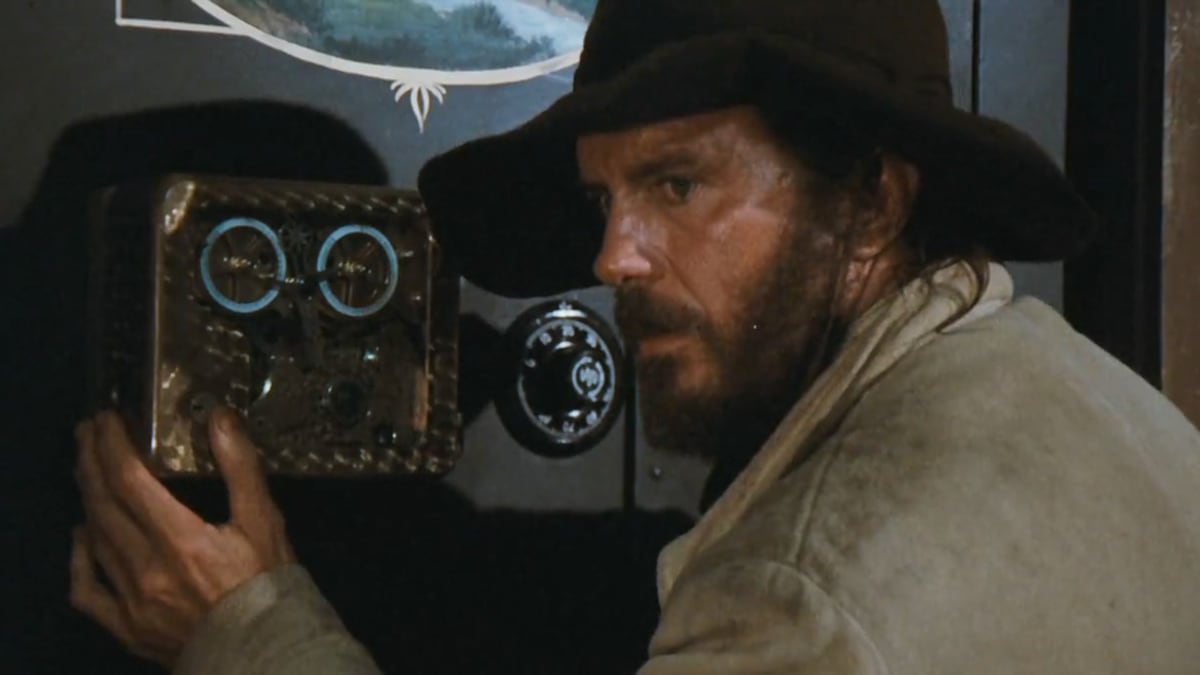As smalltown legends go, moviemaking isn’t quite Jesse James holding up your local bank. But some in Jacksonville, Oregon, still recollect when the stars rode in.
Released 50 years ago, The Great Northfield Minnesota Raid resides quietly in the upper echelon of Oregon-shot Westerns. With mythmaking on its mind and a drizzle on its face, the film reinvents the tale of Jesse James (Robert Duvall) and Cole Younger (Cliff Robertson) attempting an 1876 hit on what they dub “the biggest bank west of the Mississippi.”
Raid stands as one of the most memorable instances of Oregon going undercover for a movie set elsewhere. Directed by a burgeoning Philip Kaufman (The Right Stuff, 1978′s Invasion of the Body Snatchers), the film subsumed Jacksonville for six weeks. Streets and businesses were closed, granite was poured, power lines were buried, and local landmarks were adorned with Southern Minnesota signage.
Jacksonville’s historic boomtown aesthetic—which is still visible to this day—was what attracted the Universal production in the first place. “The town looks better than any back lot construction could,” wrote Medford Mail Tribune arts journalist Al Reiss in March 1972, paraphrasing Kaufman’s interest in Jacksonville.
They weren’t wrong. While the poster’s claim of “The West the way it really was!” is undercut by historical chicanery in the script—and Robertson’s movie-star charm—soft focus, natural light, straggly beards and Wild Bunch-influenced editing place Raid squarely in the post-Butch Cassidy and the Sundance Kid era of increasingly vivid Westerns.
When rain and snow arrived immediately on set in 1970, Kaufman committed to the mood, even simulating precipitation via fire hoses with sprinkler heads on clear days. The result is a Western uncommonly overcast and foreboding, complete with constant steam billowing from a calliope, the musical instrument stationed outside the Northfield bank to attract business.
“Why they picked November [to shoot], I don’t know!” says Larry Smith, a semi-retired Jacksonville grade school teacher who visited the set with his students at every opportunity in 1970.
From his vantage, Smith observed that Cliff Robertson was the production’s benevolent leader, riding high on a recent Oscar win for Charly (1968). Duvall, two years short of Godfather fame, enthusiastically snapped photos with local kids.
Smith remembers director Kaufman as quieter, almost stoic, letting cinematographer Bruce Surtees do most of the talking while developing a raw but aggrandizing visual style he’d soon lend to Clint Eastwood Westerns like High Plains Drifter (1973) and The Outlaw Josey Wales (1976).
Despite a few hokey imperfections—including an interminable baseball scene filmed off Applegate Highway and narration laid on thick—Kaufman’s script thrives in the deep, unfurling contrast between gang leaders James and Younger.
Played viciously by Duvall, James builds upon his bandit legacy by any means necessary. Meanwhile, Younger almost gawks at his outlaw stature in a country evolving around him. With twinkling eyes, Robertson trots out his favorite word (“wonderment”) to describe the spectacles of steam engines, titanic Northwest logs and his own fame.
In fact, the film is so alternately thoughtful and cheerful, first-time viewers may doubt its guts to attempt a compelling heist. Rest assured, that’s the money scene, scored deafeningly by the calliope’s dissonant scream, which Smith remembers reverberating on California Street for hours.
Seen today, the movie’s ruminations on legacy versus memory mirror its own journey to relative obscurity. Duvall’s star quickly eclipsed Robertson’s. Only cowboy aficionados know Cole Younger anymore. Kaufman’s later work, including co-writing Raiders of the Lost Ark (1981), outshined his earlier films.
Raid’s legacy is intimate, living under the radar and beneath Jacksonville’s sidewalks, where all the power lines buried for the movie remain. Turns out the city’s historic main drag benefited from this undergrounding of its utilities. “That was the best thing to come out of it,” laughs Smith.
Inspired by watching Robertson deliver the line mere feet away, Smith still sometimes exclaims, “Now that’s a wonderment!” in his classroom when a student “does something that really sparkles.”
Legends can be lost when half-centuries slip by, but here’s to wonderments. Remembered by some.
SEE IT: The Great Northfield Minnesota Raid streams on Roku, Starz and YouTube TV.
